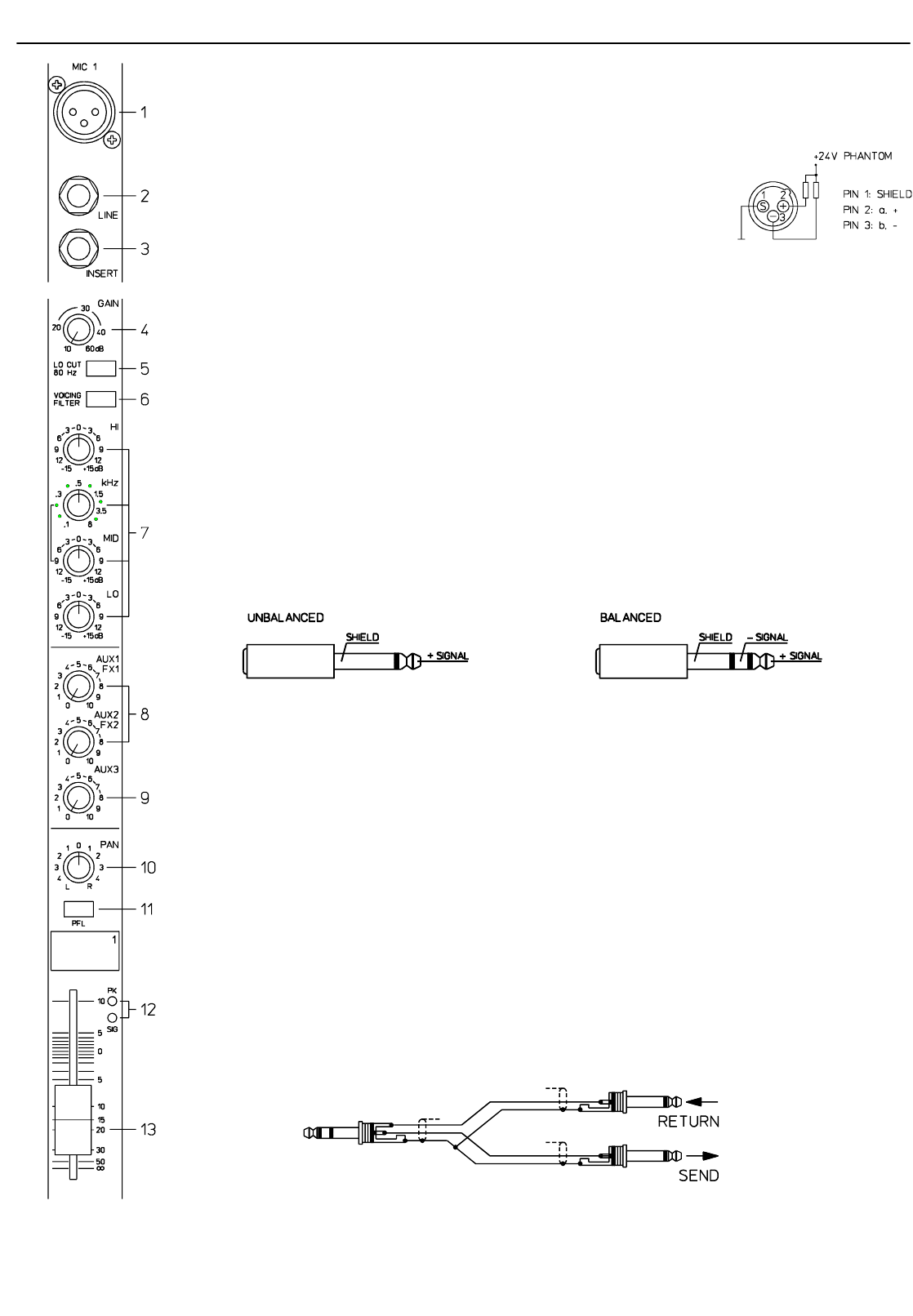
1. MIC
Electronically balanced XLR-type inputs for the connection of low impedance microphones, like the ones that are
featured in big studio -and live mixing consoles. This type of input stage provides extraordinary low- noise signal
amplification with extremely low distortion (typical <0.002%) even in the high frequency range.
Generally, any type of microphone can be connected as long as its pin assignment is
in accordance with the diagram shown aside. When condenser microphones are
connected, you have to press the PHANTOM button which is located in the master
section. The microphone gets its operational voltage (+24Vdc) through the mixer so
you can forget about battery replacement .
CAUTION: Make sure to always connect the microphones before turning on
the phantom power or switching the PSX on with phantom power activated. This is the only way to prevent your
microphones from damage. Also be sure to engage the stand-by button in the master section to prevent nasty
power-on transients.
The connection of condenser type microphones and dynamic microphone models at the same time is possible and
should generally not lead to any problems. Before you do so, please refer to the microphone’s manual to make
sure that this kind of operation is in accordance to the manufacturer’s guidelines.
The MIC input is designed for levels between –60dBu … +11dBu – depending on the setting of the corresponding
gain control. Because of their low impedance design and the phantom power these XLR-type inputs are not meant
for cascading other mixing consoles or the connection of FX units, keyboards or other electronic equipment. When
connecting this type of equipment, please use the LINE level inputs.
2. LINE
Electronically balanced inputs for the connection of electronic instruments, such as keyboards, drum machines,
electric guitars and basses with active outputs, as well as all other high-level signal sources, like additional mixers,
FX units, CD players, etc.
The LINE input is designed for levels between –40dBu and +30dBu. The connection of balanced or unbalanced
signal sources is handled with monaural or stereo phone plugs, wired according to the diagram below. If the device
that you want to connect has a balanced output stage, the use of balanced cables with stereo phone plugs is
preferable. This type of connection greatly lowers the induction of external noise or HF interference.
Do not connect signal sources to the MIC and the LINE inputs at the same time, since the signals would interfere
with each other, resulting in level reduction.
One more note: Please, do not connect electric guitars or basses with passive, high impedance outputs directly
to one of the LINE inputs. The LINE inputs of the PSX – like the line level inputs of mixers from all other
manufacturers – are meant for the connection of relatively low source impedance of electronic instruments or audio
equipment. The reproduction of the instrument’s original sound characteristics will be unsatisfactory – unless this
effect is intended. Those instruments should be connected using a special transformer, direct box or pre-amplifier
with very high input impedance. Musical instruments that are equipped with an active electronic output stage
(battery powered) can be connected without problems.
When connecting signal sources, please make sure that the corresponding channel faders or the master
faders are at their minimal settings or that the STANDBY button is engaged. This will save you, your
audience, and speakers from unpleasant pop noise.
3. INSERT
Stereo phone jack with breaker function. The low impedance output is assigned to the tip (send) and the high
impedance input (return) is assigned to the ring (body). This jack allows the connection of external compressors,
limiters, EQs, etc. into the corresponding channel’s signal path. The insertion point is post gain controls, low-cut
filters, and voicing-filter stage and pre-EQ section and faders. You have to use a stereo phone plug wired according
to the following diagram – in case you intend to use this jack as a true insert bus.
INSERT
INPUT/MONO
4 of 32


















